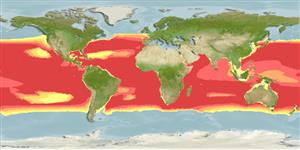>
Myctophiformes (Lanternfishes) >
Myctophidae (Lanternfishes) > Myctophinae
Etymology: Benthosema: Greek, benthos = depth of the sea + Greek, sema, sematos = signal, flag (Ref. 45335).
More on author: Gilbert.
Environment: milieu / climate zone / depth range / distribution range
Ökologie
seewasser bathypelagisch; ozeanodrom (Ref. 51243); tiefenbereich 50 - 2500 m (Ref. 26165), usually 500 - 600 m (Ref. 4775). Deep-water; 50°N - 50°S, 180°W - 180°E
Circumglobal in tropical and temperate waters, but with a distinct equatorial gap in the Pacific (Ref. 9835). Western Atlantic: Canada to Brazil. Eastern Atlantic: Morocco to Mauritania and from Liberia to Namibia (absent in Mauritanian Upwelling Region). Indian and Pacific: confined to southern equatorial water masses, extending to 50°N and 50°S in western boundary currents. South China Sea (Ref.74511).
Length at first maturity / Size / Gewicht / Alter
Maturity: Lm 2.3 range ? - ? cm
Max length : 3.9 cm SL Männchen/unbestimmt; (Ref. 4479); max. veröff. Gewicht: 0.60 g (Ref. 126117); max. veröff. Alter: 0.90 Jahre (Ref. 4882)
Rückenflossenstacheln (insgesamt) : 0; Rückenflossenweichstrahlen (insgesamt) : 12 - 14; Afterflossenstacheln: 0; Afterflossenweichstrahlen: 16 - 19; Wirbelzahl: 33 - 35.
High-oceanic, epipelagic to mesopelagic, found in 375-750 m during the day and near the surface to 125 m at night (Ref. 4066, 58302). Adults feed on zooplankton (Ref. 9835). Caudal glands develop in both sexes from about 1.9 cm (Ref. 4775). Oviparous, with planktonic eggs and larvae (Ref. 31442).
Hulley, P.A., 1990. Myctophidae. p. 398-467. In J.C. Quero, J.C. Hureau, C. Karrer, A. Post and L. Saldanha (eds.) Check-list of the fishes of the eastern tropical Atlantic (CLOFETA). JNICT, Lisbon; SEI; Paris; and UNESCO, Paris. Vol. 1. (Ref. 4479)
IUCN Rote Liste Status (Ref. 130435: Version 2024-1)
Bedrohung für Menschen
Harmless
Nutzung durch Menschen
Tools
Zusatzinformationen
Download XML
Internet Quellen
Estimates based on models
Preferred temperature (Ref.
123201): 6.1 - 13, mean 8.8 °C (based on 228 cells).
Phylogenetic diversity index (Ref.
82804): PD
50 = 0.5312 [Uniqueness, from 0.5 = low to 2.0 = high].
Bayesian length-weight: a=0.00977 (0.00488 - 0.01958), b=3.14 (2.97 - 3.31), in cm total length, based on LWR estimates for this species & (Sub)family-body (Ref.
93245).
Trophic level (Ref.
69278): 3.4 ±0.45 se; based on food items.
Widerstandsfähigkeit (Ref.
120179): hoch, Verdopplung der Population dauert weniger als 15 Monate. (K=3.65; tm=0.4; tmax=0.9).
Fishing Vulnerability (Ref.
59153): Low vulnerability (10 of 100).
